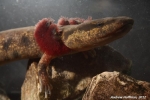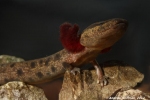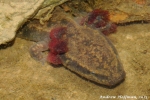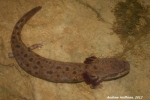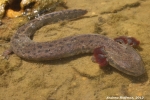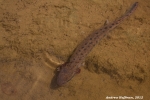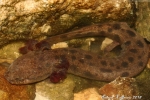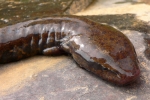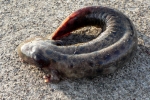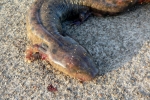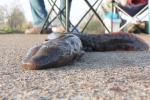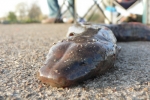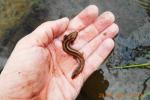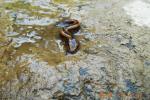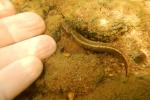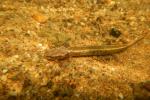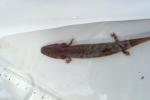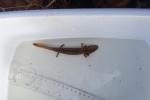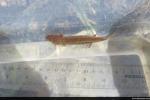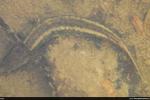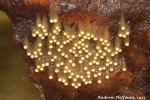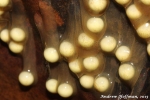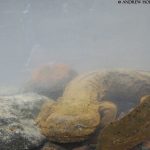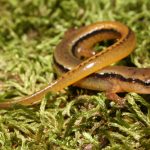Common Mudpuppy
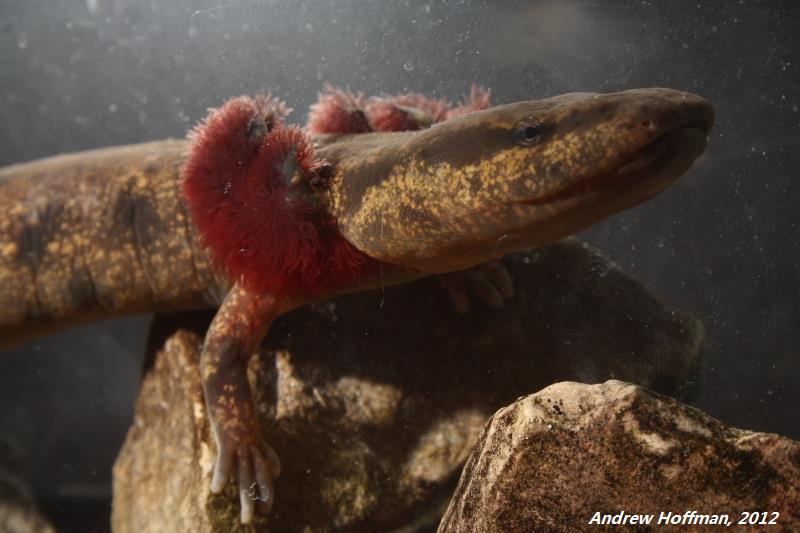
Scientific Name: Necturus maculosus
Size: 8-13 inches (20-33 cm) in length
Status: Species of special concern
PAHERP Resource: Monsters in the Water
Habitat:
Clear open lakes with sandy bottoms, ponds, and fast-flowing streams and creeks.
Description:
Large and stout species; permanently aquatic. The background color is grayish brown, reddish brown to black and becomes lighter on the sides of the body down to the lateral margins of the ventral. The body has a series of irregular blotches. Small blotches may extend onto the posterior dorsal on the head. The underside is beige or cream to pinkish gray and sometimes may be covered with small bluish black blotches. The head has a dark stripe that extends from the nares though the eyes and ends at the gills. The body is stout and somewhat dorsolaterally compressed. The head is flat and broadest just behind the eyes and tapers to a truncated snout. The eyes are small, dark and lidless. There are three pairs of bushy external gills that are present at the junction of the neck and head.
The legs are small and not well-developed. The feet have four toes. The tail is short and strongly compressed laterally with a distinct caudal fin. The larvae of some species like the two-lined salamander has often confused with the mudpuppy.
- The dorsal background color is greyish brown, reddish brown to black and becomes lighter on the sides of the body down to the lateral margins of the ventral.The dorsal has a series of irregular blotches. Small blotches may extend onto the posterior dorsal on the head.
- The ventral is beige or cream to pinkish grey and sometimes may be covered with small bluish black blotches.
- The head has a dark stripe that extends from the nares though the eyes and ends at the gills.
- Large and stout species; permanently aquatic.
- The body is stout and somewhat dorsolaterally compressed.
- The head is flat and broadest just behind the eyes and tapers to a truncated snout.
- The eyes are small, dark and lidless.
- There are three pairs of bushy external gills that are present at the junction of the neck and head.
- The legs are small and not well-developed.
- The feet have four toes.
- The tail is short and strongly compressed laterally with a distinct caudal fin.
- The dorsal is dark with lateral stripes that are separated by pale yellowish cream to light greenish stripes.
- The tail is long.
- The ventral is immaculated cream or beige.
- The dorsal had a dark band that extends down the midline of the back that is bordered by a light yellow stripe. A dark broad band occurs below the yellow stripes.
- The yolk sac is present with hatchlings.


References:
- Hulse, C. and McCoy C. J. and Ellen Censky ,1998. Amphibians and Reptiles of Pennsylvania and the Northeast. 44-48pp.
- Petranka, James W. ,1998. Salamanders of the United States and Canada. 425-429pp.
- Jeff Hankey
- Rex Everett
- Andrew Hoffman
- Chris Bortz
- Brandon Hunsberger
- Aaron Semasko
- K R Anderson II
Heads up!
Please contribute your observation of this and other herps to the Pennsylvania Amphibian and Reptile Survey. Your help is needed.
